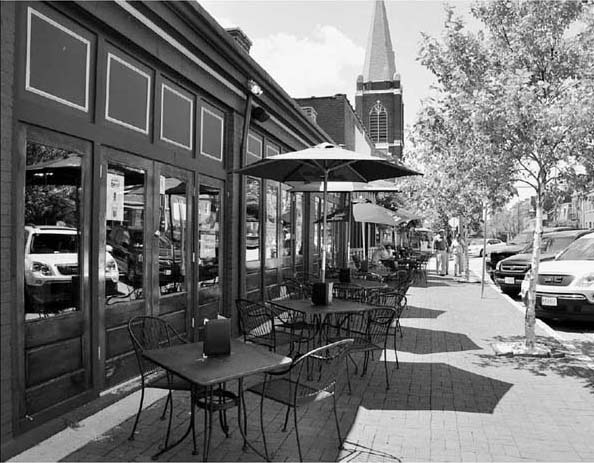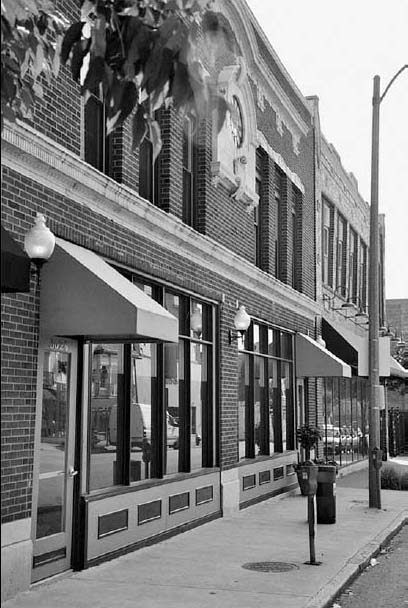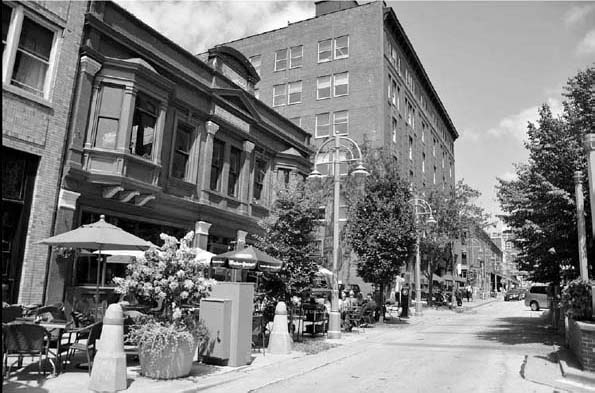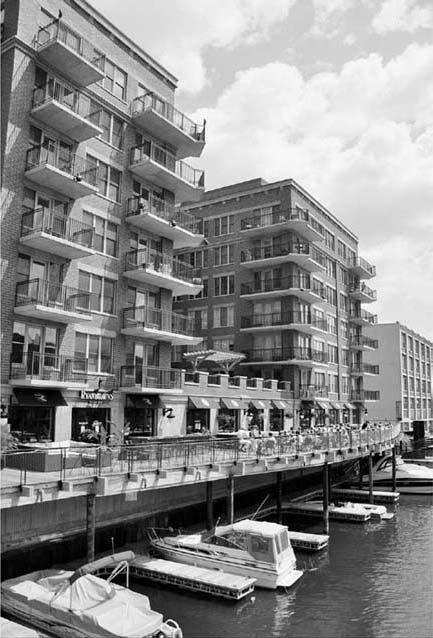
Restoring Urbanism in U.S. Cities
SynergiCity as Prototype
Peoria, Illinois, is the very symbol of the midwestern American city. “But will it play in Peoria?” was the question vaudeville show producers asked themselves before launching a nationwide show tour. Now the phrase is used as inside-the-Beltway shorthand for whether an issue with appeal to Washington, D.C., elites can also appeal to the average middle-class American. However they’ve played politically, federal programs and policies have significantly impacted Peoria and other U.S. cities.
This book’s lead authors, Paul Hardin Kapp and Paul J. Armstrong, researched Peoria, Illinois. In chapter 2 they describe Peoria as a potential “Synergy City”: a city that embraces its complexity, diversity, and connectedness to create a fertile and attractive environment for economic and cultural development. A nineteenth-century river town and farm service center with an industrial sector led by heavy equipment manufacturer Caterpillar, the greater Peoria area has enjoyed a steadily prosperous economy in much of the postwar period. The city’s population was about 113,000 in 2000 (2000 U.S. Census) and peaked at around 127,000 in 1970. The 2010 census indicates that the population, at around 115,000, is rising again. The five-county metropolitan population has continued to grow and now exceeds 375,000. Peoria resembles many other Midwest cities, some with modestly growing metropolitan areas, others experiencing stagnant or declining city populations. Toledo, Ohio, Racine, Wisconsin, Evansville, Indiana, and many other cities share this situation. Each has also experienced decentralization of its population and decline in its downtown and central neighborhoods. Large Midwest cities like St. Louis, Buffalo, Milwaukee, Detroit, Pittsburgh, Cincinnati, and Cleveland have also lost significant population to their expanding suburbs. In all cases the reasons for decline are complex.
Overall reduced growth in nationwide manufacturing explains part of it. But Midwest industrial cities should be cautious about writing off their manufacturing sectors. Much of the service sector growth in the last decade was debt-leveraged real estate and banking activity that is now shrinking relative to manufacturing. Furthermore, many manufacturing processes are quieter and safer than those of the past and can be allowed and encouraged in urban neighborhoods like Peoria’s River Warehouse District. Form-based code that encourages mixed uses, including live/work units, can serve as a great setting for the synergy the authors advocate (fig. 6.1).
Development: The Impact of the Automobile
Richard Florida’s writings promote development that attracts the well-educated professional class. He cites examples like New York City’s Soho with its condos, art studios, and chic shops converted from warehouses and factories. Soho is now mostly housing, galleries, and shops, with few industrial activities. Yet we should remember that it was Soho’s urban industrial atmosphere that helped attract artists and hipsters in the first place. Craftsman, artists, and artisans can fit nicely with small-scale manufacturing. Milwaukee’s Third Ward warehouse district includes galleries, pricey condos, shops, and restaurants but still retains the wholesale produce commission, machine tool shops, and even a small-scale steel producer (plate 14). In the 1960s Milwaukee tried to remove most of what had been a lively Italian neighborhood.

FIGURE 6.1. The Soulard neighborhood in St. Louis, Missouri, incorporates a residential, retail, and restaurant mix that enhances the character of the district and animates the streets. (Courtesy of Paul J. Armstrong)
Housing was removed to make room for suburbanstyle industrial lots. The old buildings left were to be designated a “combat zone” for porn shops and gentlemen’s clubs. Fortunately, the city ran out of money and ran into resistance from property owners before the job could be completed. When I became mayor in 1988, the plan had shifted to rehabilitation and renovation. Property developers were already creating Milwaukee’s version of Soho. To facilitate the transition to housing and galleries, the city was seeking to move the produce commission to a remote site. The argument was that the morning truck movements and hustle and bustle of Commission Row were incompatible with residential living. I opposed this plan, and the commission merchants stayed. I felt that turning the mixed-use Third Ward into a condo ghetto was as mistaken as the earlier attempts at making it into an industrial zone. The Third Ward has prospered since, adding over 2,000 new residents while retaining much of its industrial character.
In addition, old Midwest cities like Peoria have suffered from federal and state programs and local policies that undermine urbanism and population density while subsidizing and encouraging decentralization, which is often referred to as sprawl. For example, the interstate highway program subsidizes grade-separated highways that facilitate fast long-distance travel by motor vehicle. Connecting distant metros by express roads holds benefits for travelers, and interstates hold a practical utility that makes great sense in rural areas with low costs per acre and few if any existing structures to remove. But in densely populated and built-out cities, the roads are expensive, can undermine property values, and disrupt the efficiency of existing street networks. The large grade, separated highway undermines one of the fundamental assets of cities: location efficiency. If two people hold similar jobs and one person walks across the street to work and the other drives 25 miles, their value to the economy is the same, but their cost is not. The government rewards the longer, energy-consuming trip with a large subsidy and ignores the value of the short walk. Federal policy should support economic value without disadvantaging compact urban development served by energy-efficient transit, as Harvard economist Ed Glaeser has argued persuasively (“Why the Anti-urban Bias?,” Boston Globe, March 9, 2010).

FIGURE 6.2. In Midtown Alley in St. Louis, the developer targeted a specific business market, such as advertisement agencies, commercial photographers, and graphic designers, as tenants to create a critical mass of “destination businesses” for the district. (Courtesy of Paul J. Armstrong)
The clear and oft-stated goal of federal transportation policy is to reduce congestion. This narrowly focused objective clashes with the very purpose of cities as a gathering spot for commerce and cultural interaction (fig. 6.2). Let’s face it: successful cities become congested because people choose to be in them. Cities like New York, Portland, Oregon, and San Francisco, with vibrant economies and high real estate values per square mile, experience congestion. However, it is not just traffic congestion but also people, money, and job congestion. Cities like Detroit and Buffalo, with shrinking economies and low real estate values, have low congestion. They also may have low congestion because they are crisscrossed with freeways. In one way the freeway building in Detroit and Buffalo has succeeded in achieving the stated goal of government policy, as delineated in the Highway Capacity Manual and AASHTO Geometric Design of Highways and Streets (“Green Book”) of the American Association of State Highway and Transportation Officials (AASHTO). The AASHTO system would rate Detroit quite highly; the Green Book lists the following levels of service:
A = Free flow
B = Reasonably free flow
C = Stable flow
D = Approaching unstable flow
E = Unstable flow
F = Forced or breakdown flow
By this measure, congestion is no longer much of a problem for Detroit. While cities like New York City and San Francisco suffer from congestion ratings of E and F, Detroit enjoys almost free-flowing traffic. So while federal and state transportation agencies value low congestion, the market, as measured by real estate prices, values places with high levels of congestion.
Cities are beginning to understand that focusing narrowly on moving traffic on big roads is counterproductive. In 1975 New York City’s West Side Highway fell down. The expressway, built in the 1930s, was literally at the end of its design life of 40 years. The elevated roadway blocked views of the Hudson River from Chelsea, Tribeca, and the Battery. The neighborhoods wanted their views back. They wanted to reconnect with the river. After a struggle that lasted more than a decade the decision was made to replace the expressway with a surface thoroughfare, West Street. It paid off in higher real estate values, more development, and more jobs. Similarly, San Francisco and Portland eliminated freeways and gained population, jobs, and housing. In Milwaukee we sought the elimination of the Park East Freeway on the north end of downtown. After a decade of struggle we opened McKinley Boulevard in 2003. It replaced the freeway and is the now a lucrative site for development. Manpower Inc., a Fortune 500 corporation, moved from the suburbs to a site adjacent to the boulevard. Thousands of new housing units have been added to the neighborhood, and traffic distribution has actually improved without the freeway. Many millions of dollars worth of development has occurred along the corridor. One cautionary note: Milwaukee County, which owned almost 90% of the land under the Park East Freeway, encumbered the right-of-way with “community benefits” restrictions on developers, contractors, and landowners that have slowed development in the right-of-way itself. Adjacent properties have surged in value, but the social restrictions have, in my opinion, been a drag on redevelopment.
Traffic that is just moving through cities without visiting holds little or no value for the city, while traffic that is moving to a destination within the city can hold great value. Traffic congestion is a bit like cholesterol. There is both good and bad cholesterol, and cholesterol levels need to be managed, not eliminated. Trying to defeat congestion without considering the nature of particular traffic can generate collateral damage that can severely hurt a city’s vitality. Peoria and many other cities removed on-street parking to free up room for through traffic. With the same objective, they have also converted two-way streets to one-ways. Both these actions hinder shoppers’ ability to conveniently visit downtown retailers. Jefferson and Adams are the main north-south streets in downtown Peoria. They should be the bustling centers of Peoria’s commerce and civic life, but instead they are devoted to moving cars during Peoria’s very brief commuter rush period. The threat of congestion was also addressed by the construction of Interstate 74, a giant structure built through downtown. Peoria’s one-way pairs and I-74 are clear examples of infrastructure serving the government’s narrow-minded battle against congestion even though there is little congestion to be concerned about.
Zoning versus Form-Based Coding
Another example of a policy that undermines urbanism is the application of strictly separated-use zoning to cities. Such zoning was promoted by the federal government starting in 1931 in an executive order issued by President Herbert Hoover. Having served as administrator of the U.S. relief effort to help a devastated Europe recover at the end of World War I, Hoover felt that U.S. cities, like those in Europe, were crowded and dirty and needed to spread out and separate commerce from housing. Although his order was more exhortatory than mandatory, its underlying intent remains embedded in many federally created policies and programs, including the two huge federal guaranteed secondary mortgage markets, Fannie Mae and Freddie Mac, as well as the Department of Housing and Urban Development’s 21(d) capital subsidy program for multifamily rental housing. Separate-use zoning has undermined the value of existing neighborhoods and had the effect of mandating new development to be separated into pods, with housing, retail, and office uses strictly separated. This confounds efforts to build a traditional Main Street with apartments built above storefronts. Luxembourg architectplanner Leon Krier compares experiencing the traditional city to eating a delicious chocolate cake, properly assembled from ingredients and carefully baked. He then describes U.S.-style suburban sprawl as like the ingredients of the cake; the sugar, water, cocoa, flour, and baking powder are spread over the kitchen counter and then consumed separately. Not very tasty! It is, Krier says, the complexity, connectivity, and diversity of the properly assembled city that are most enjoyable.
Many federal and state policies have encouraged sprawl and undermined urbanism, but market and demographic forces, as described by Chris Leinberger in The Option of Urbanism: Investing in the American Dream, have begun to favor urban places. As household sizes shrink, demand increases for urban forms such as apartments and townhouses. Young adults seeking greater social and job opportunities prefer urban living. Urbanism is more popular, so now would seem to be a good time to change rules and policies that discourage it.
In Milwaukee, as mayor from 1988 to 2004, I set out to reform coding and zoning to encourage mixed uses in commercial and retail corridors (fig. 6.3). The code reforms adopted in Milwaukee “legalized” urban forms like apartments or offices above shops. Setback requirements for buildings were adjusted to encourage construction of buildings along sidewalks and closer to streets. I encouraged city planners to do the same in newer portions of the city, where setbacks from streets had been set as deep as 100 feet, often with no provision for sidewalks.
In some older portions of the city, zoning overlays had been imposed on commercial streets in the 1950s and 1960s that made existing buildings nonconforming use and thus condemnable for the purpose of eventually widening streets. This had the effect of undermining property owners’ ability to attract capital to repair or improve their property, as banks and title insurance companies held no interest in assuming risk in property likely to face condemnation. For example, one of Milwaukee’s east-west thoroughfares (National Avenue) is 54 feet wide — wide enough for two moving lanes in each direction plus a lane on each side for parking. The City Council of Milwaukee, at the request of the Public Works Department, in 1962 imposed a setback on the south side of the street that would create a travel surface of 72 feet, thus providing room for two additional lanes. If this policy had been carried to completion, three miles of buildings collectively worth many millions of dollars would have been removed to speed up traffic on National Avenue. Instead, we repealed the nonconforming-use setback and legalized the avenue’s existing dimensions.

FIGURE 6.3. Milwaukee’s Third Ward uses form-based codes to create a mix of uses that contribute to livability. (Courtesy of Paul J. Armstrong)
The Problem of Parking
Another counterproductive encumbrance on urban property is off-street parking regulation. Water Street runs along the west side of Milwaukee’s City Hall. In the early 1960s off-street parking requirements were imposed on private property on Water Street. A building with a frontage of 19 feet had been lost to fire. The new ordinance required seven off-street parking spots on the lot, even though it was only 70 feet deep and the other buildings on the block were three and four stories. As a result, the lot sat vacant for 35 years until we relaxed the off-street parking requirement. A four-story mixed-use building was constructed almost immediately after the change. Cities all over America have unnecessarily repressed their own real estate development with counterproductive parking requirements. Don Shoup, a UCLA economist, wrote a book about it, The High Cost of Free Parking. He discourages local officials from requiring parking and instead urges them to leave that decision to property owners and their tenants — according to Shoup, most medium and large U.S. cities underprice on-street parking. In addition, they not only have parking regulations that undermine the value of the city but wastefully invest taxpayer funds in underutilized publicly owned parking.
All of these interventions — oversized streets, separated uses, and parking minimums — derive from an attitude that undervalues urbanism. Fortunately, the current markets do place a higher value on urbanism (fig. 6.4).
A New Urban Policy
At the end of World War II, the United States was triumphant and undamaged by war. Many of the cities of Germany and Japan — Hamburg, Dresden, Berlin, Tokyo, Hiroshima, and Nagasaki — lay in near total ruin. America had won, and Germany and Japan had lost. U.S. cities had produced much of the war material that fueled the Allied victory. No city was more productive on either side of the battle lines than Detroit, which produced tanks, jeeps, artillery, aircraft, ammunition, and firearms. At war’s end Detroit had nearly 2 million people, a vast streetcar system, quality housing, and a vibrant downtown. It was a well-planned city with the Woodward Plan, named for Augustus Woodward, modeled after the L’Enfant plan of Washington, D.C. Its radiating streets carried motor vehicles and served as trunk routes for a vast streetcar system. After World War II the plan was ignored, a system of freeways was built, and the streetcars were removed.

FIGURE 6.4. Condominiums along the Milwaukee River in Milwaukee’s Third Ward bring vitality to the river. (Courtesy of Paul J. Armstrong)
How did this work out for Detroit? Today all the cities of Germany and Japan are rebuilt, while Detroit, having lost more than half its population, looks as though it was Ground Zero for World War II. Other industrial cities have also suffered, usually not to the extent of Detroit, but enough to appear in dire need of repair. Pittsburgh, Buffalo, Gary, Indiana, St. Louis, and Cleveland all lost half their populations between 1950 and 2000, and many medium- and small-sized industrial cities shrank as well.
There are, of course many reasons that U.S. cities deteriorated in the post–World War II period. New technology, particularly the automobile, changed travel patterns in a way that undermined the supremacy of downtowns as centers of commerce. In addition, as America prospered, many citizens freely chose to enjoy their prosperity in larger houses on larger lots outside the city. Yet a significant part of the decline of U.S. cities can be traced to U.S. transportation and housing policies that distorted markets and pushed decentralization far beyond where market forces alone would have taken it. The federal government and, by extension, state governments subsidized and otherwise encouraged, through regulation, nonurban forms of development.
Since the Great Depression, municipal organizations like the U.S. Conference of Mayors and the National League of Cities have frequently called for a Federal Urban Policy. This is a good example of the oft-repeated caution “Beware what you ask for.” Let’s assume that by policy they mean federal programs that benefit cities, particularly city governments. Revenue sharing, federal block grants, disaster relief, Homeland Security grants, energy grants, housing programs, and most recently stimulus funds are all programs that have provided cash to local governments. Some programs currently exist; others have been canceled. Revenue sharing, enacted under President Richard Nixon, was ended under President Reagan. While federal aid to cities is often discussed, it might surprise people to know that cities actually get little of their revenue from the federal government. In most years it’s less than 5%, and the biggest share of that is assistance to public housing residents.
While not a major source of discretionary revenue, the federal government, from the nation’s founding, has had a powerful impact on cities both for good and ill. Perhaps the most beneficial federal contribution to cities is the U.S. Constitution and especially the Bill of Rights. Individual freedom is important to the culture and economy of cities. Another great federal contribution to U.S. cities is the guarantee of free commerce among the states without restrictions or tariffs. In many other ways the federal government has undermined cities. Changing the federal antiurban rules and policies to allow or even encourage urbanism would only help cities.
More successful cities will, in turn, also help America. More compact, complete, and wellconnected development will save energy and add efficiency to the American economy. Urbanism also brings social benefits to communities. As it says in the preamble to the Charter of the New Urbanism:
The Congress for the New Urbanism views disinvestment in central cities, the spread of placeless sprawl, increasing separation by race and income, environmental deterioration, loss of agricultural lands and wilderness, and the erosion of society’s built heritage as one interrelated community-building challenge. (www.cnu.org/charter)
For cities, states, and certainly the federal government, it is the right time to address that challenge.